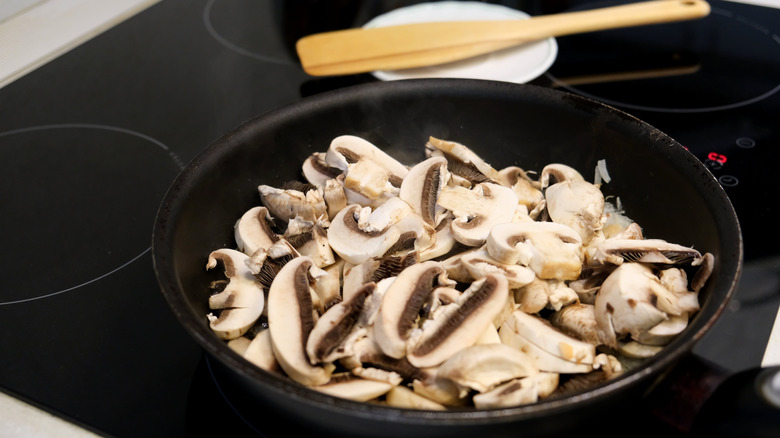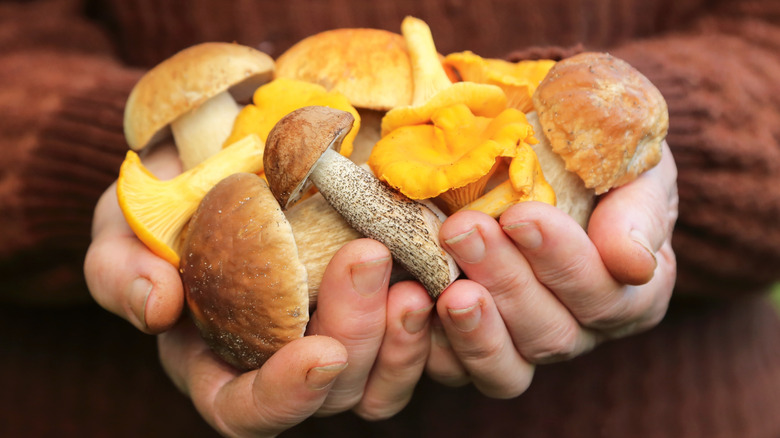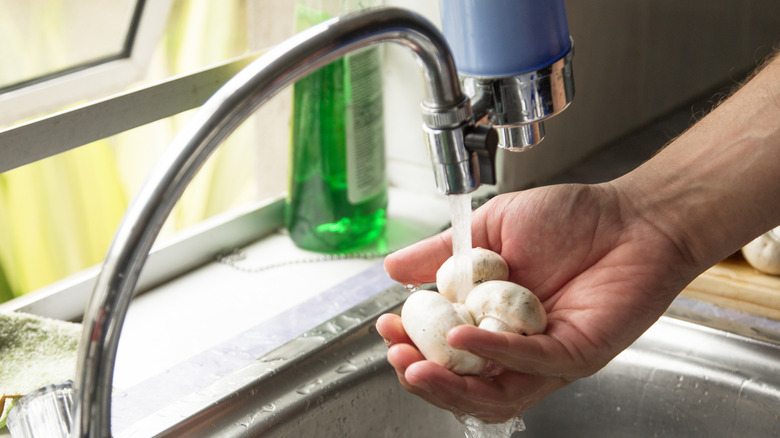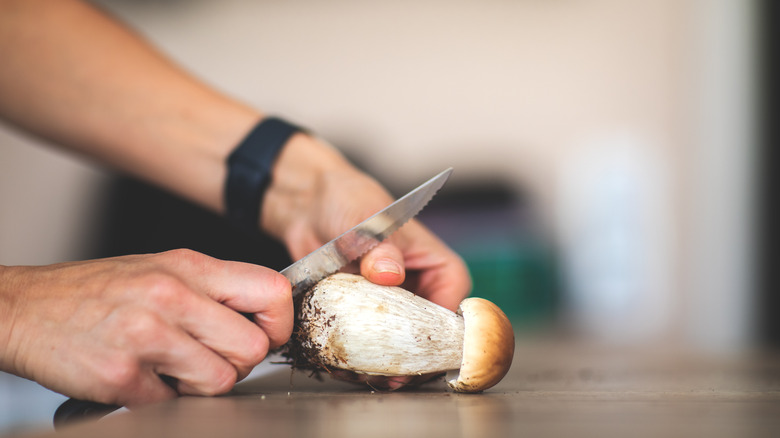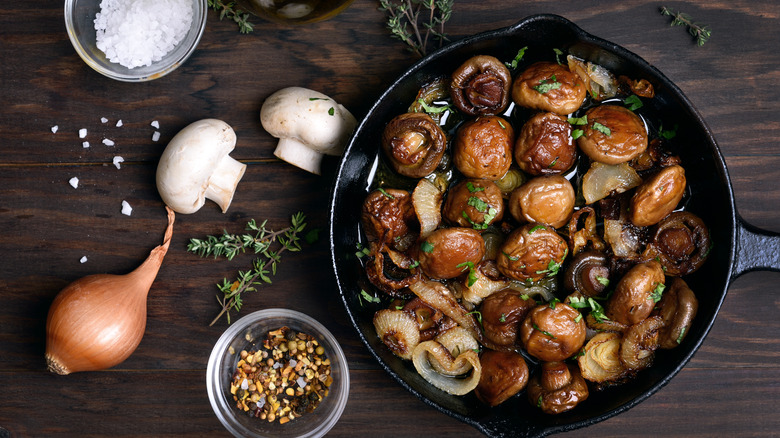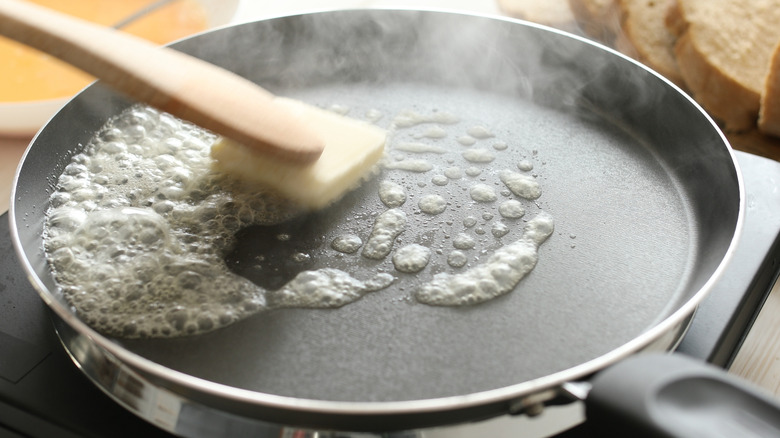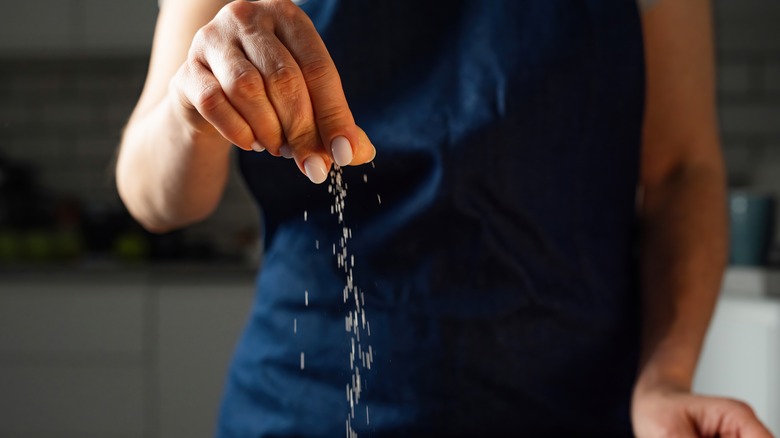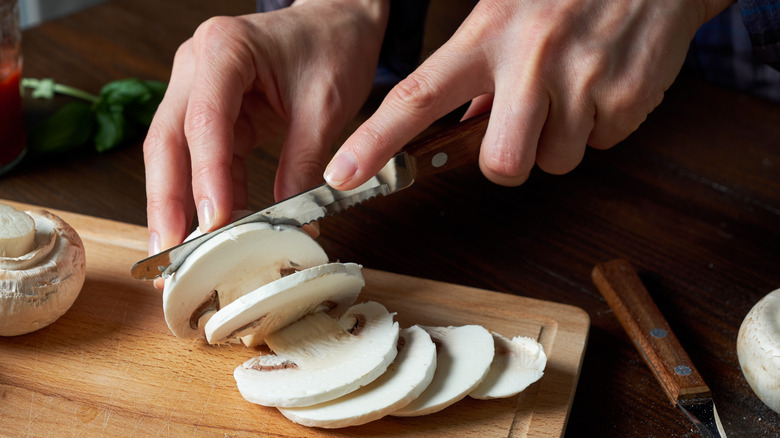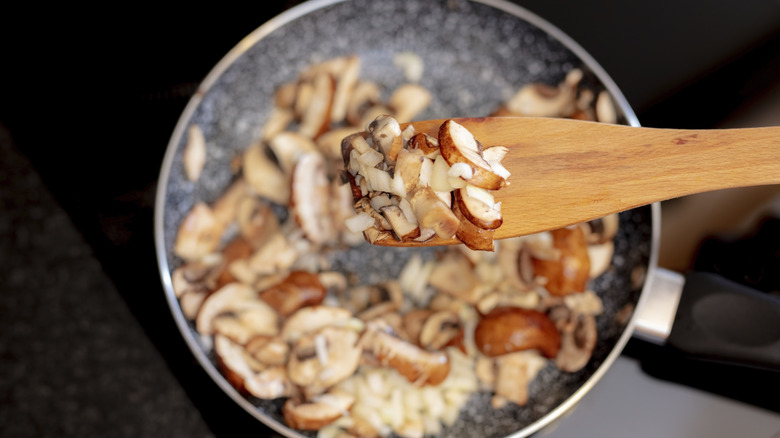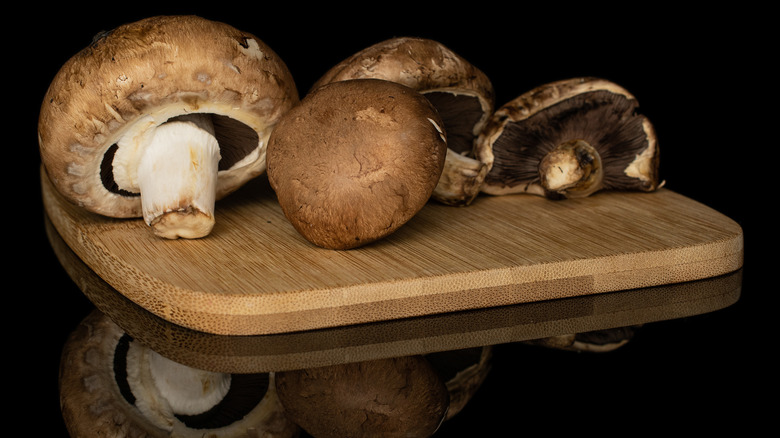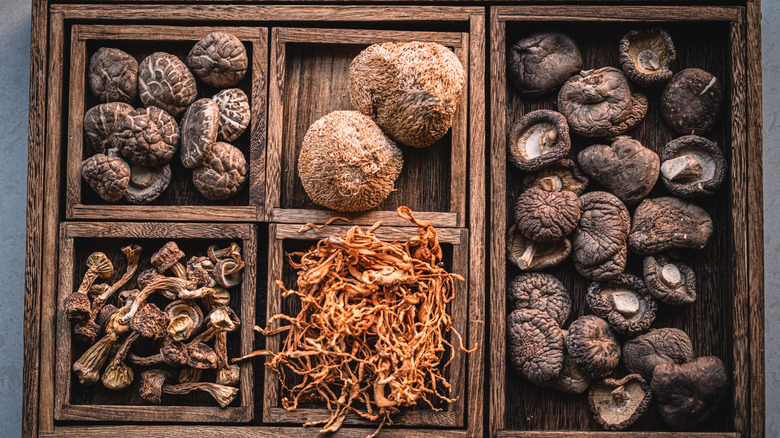Mistakes Everyone Makes When Cooking Mushrooms, Explained By Experts
We may receive a commission on purchases made from links.
Mushrooms. You either love 'em or you hate 'em. If you hate them, it could be because you don't know how to cook with them to ensure they have the best flavor and texture. And, even if you love them, you could be missing out on experiencing how truly exceptional they can be and just how much they can enhance your favorite recipes if you don't know how to cook them properly.
Unfortunately, mushrooms are not as simple to cook with as one may think. There are several mistakes you might be making that could be negatively impacting the texture of the mushrooms, their flavor, and how they add to — or subtract from — the overall quality of your meal. To help us understand more about some of these common mistakes with cooking mushrooms, and what should be done instead, we reached out to three experts. Rachel Lessenden is a nutritionist, a chef, and the founder of Health My Lifestyle, Nadia Liu Spellman is the founder, CEO and chef at Dumpling Daughter, and Sophina Uong is the chef and co-owner at Mister Mao.
Not choosing the right type of mushroom
Mushrooms are mushrooms, right? Well, no, not quite. There are several different types of mushrooms, including white button, shiitake, oyster, crimini, and lion's mane. Each variety is unique and offers its own flavor profile and texture. It is essential to be purposeful when choosing which type of mushroom to use for each dish you plan to make. And, if you're following a recipe, stick to the variety called for in the ingredients list or perform some research to identify a suitable substitution.
"For example, a recipe that calls for white button mushrooms probably shouldn't have shiitake used instead," says Rachel Lessenden. Shiitake mushrooms have a strong, earthy flavor that can overpower other delicate flavors." Moreover, Lessenden notes that the texture of a shiitake mushroom is much chewier than many other varieties, which could negatively impact a recipe that needs a mushroom to absorb the flavors (like a delicate button mushroom).
Not properly washing mushrooms
You might know that the best place to store mushrooms is in the refrigerator. But do you know the best way to wash them before slicing or cooking them for a recipe? Mushrooms grow on the ground, so many assume they need to be thoroughly washed and scrubbed. However, lots of water and mushrooms are not a good combination. "When cooking mushrooms, I never feel a need to wash them unless they are heavily soiled. It adds too much liquid to the mushroom when cooking. A gentle wipe with a damp towel can help clean it," explains Nadia Liu Spellman.
Rachel Lessenden notes that this extra water can make the mushrooms take longer to cook or even dilute their flavor profile. If you notice that the mushrooms are heavily solid, Lessenden says to wash them quickly using cold water. "Just make sure to immediately pat them dry with a lint-free towel or paper towel to remove excess moisture." Moreover, she explains, "Don't slice or chop your mushrooms before cleaning, or they'll absorb too much excess water, which will make it harder to pat dry and longer to cook."
Discarding the entire stem
When you're prepping your dish, the mushroom stem might not look the most appetizing. It may be tempting to discard it and only use the mushroom cap. However, according to Rachel Lessenden, doing so would be a mistake.
After trimming the dry or tough end of the stem, Lessenden recommends slicing the stem with the rest of the mushroom cap. "Mushroom stems add more flavor and texture to the dish, adding complexity," she notes. There are a few exceptions to this rule, however. The stem of a shiitake mushroom is very chewy, so you might want to cut it off before slicing these mushrooms. You still don't need to throw the stem away and let it go to waste. After trimming off the end, save these stems to use when making stocks and soups — you can even freeze them for future recipe needs.
Overcrowding the pan
If you really like mushrooms or are doubling a recipe, it may be tempting to stuff as many as you can into the pan. This, however, is not a good idea. "Overcrowding them makes them sweat instead of sear. If you want them to have the best flavor, don't do it," cautions Sophina Uong. Conversely, when the mushrooms are well spaced out, more air can circulate as they cook. This will help ensure that the edges can get a little crispy, ensuring the best flavor and texture for your finished piece.
Depending on the recipe and the number of mushrooms it calls for, you might need to cook them in batches. At a minimum, you'll want to have a wide skillet, such as a 12-inch Farberware nonstick frying pan, that provides you with a larger cooking surface to ensure the mushrooms have the space they need to cook properly.
Adding butter too early
Buttery mushrooms are certainly delicious. Whether you're serving mushrooms as a side dish or adding them to a favorite pasta recipe, adding butter is often a good idea. However, Sophina Uong warns us, "if you add the butter in the beginning, it will burn too fast before the mushrooms get cooked."
Another reason to hold off on adding the butter – or any other cooking fats, for that matter — relates to the flavor of the mushrooms. When you cook mushrooms, they release their juices. Leaving the pan free of butter or other fats helps ensure that this delicious mushroom flavor is reabsorbed and concentrated for the best result. Once the mushrooms have nearly finished cooking (you can tell they've reached this point when most of the moisture has been released), you can add butter if desired.
Adding salt too soon
Learning how to properly season proteins, vegetables, and fruits when cooking them isn't always so easy. This may be why many people make the mistake of seasoning their mushrooms too early. It can be confusing; maybe you didn't realize you're supposed to salt apples before baking them. However, according to Rachel Lessenden, "If you salt as soon as you place the mushrooms in the pan, it will draw out the moisture too quickly, making it harder to caramelize evenly, and the mushrooms will end up rubbery."
Instead, exercise patience and put that salt shaker down until your mushrooms have cooked for a while. Lessenden adds, "The best time to salt is after the caramelizing has started, close to the end of cooking." This is another reason to wait until near the end of the cooking process to add butter — particularly if you're using salted butter. You want to keep the salt away to avoid interfering with the caramelization process.
Cutting uneven slices
Be sure to take your time when slicing your mushrooms. It is important to cut evenly-sized slices. Sophina Uong states, "Slices cut unevenly, cook unevenly, and brown at different times." This can spell big trouble for your finished dish. The smaller mushroom slices will cook more quickly, meaning they could end up overcooked, while the thicker slices still need to be fully cooked. If you're not an experienced chef, you won't want to cut the mushrooms freehand over the pot. Instead, work on a cutting board with a good knife. If you cook with mushrooms frequently, you could consider investing in a mushroom slicer, like the Norpro mushroom/egg slicer, which will help ensure you get even slices every time.
When slicing your mushrooms, you will also want to think about the recipe you're preparing. "The cooking time will dictate the shape and size of the mushroom you will cut. Shorter cooking times will have smaller, finer-cut mushrooms," explains Nadia Liu Spellman.
Undercooking mushrooms
Just as you don't want to make the mistake of undercooking green beans, you also shouldn't serve mushrooms that haven't had enough time to cook fully. "Undercooking mushrooms can result in a tough and chewy texture that's less flavorful. Mushrooms need time to sweat out the excess moisture, so they may end up soggy as well," says Rachel Lessenden. Instead, she explains that they'll be able to caramelize, absorb flavors, and become tender when they are given ample time to cook.
Beyond the much more desirable taste and texture of properly-cooked mushrooms, Lessenden cautions that raw or undercooked mushrooms may be unsafe to eat. Some, notably white button mushrooms, may be toxic to eat when they're raw. "White button mushrooms contain a compound called agaritine, which may be carcinogenic. Agaritine is heat-sensitive so cooking lowers the levels," Lessenden notes.
Not preparing portobello mushrooms properly
There are mushrooms, and then there are portobello mushrooms. While most other varieties are relatively small and fine, portobello mushrooms are much larger and thicker. Because of their size and texture, you'll often see them as a vegetarian or vegan stand-in for a burger or other typically meat-based dish. While cooking these shrooms isn't overly complicated, it is a bit less straightforward than preparing some other varieties, and you don't want to make a mistake.
"They should be gutted (the black gills spooned off) the tops of the portobello peeled and dehydrated with the gills for umami powder. When you peel a mushroom, the color is so much nicer after cooking. This is purely for vanity; it's like making the lowly portobello into a beautiful princess," explains Sophina Uong. When the cap of the mushroom is peeled — or at least scored — steam will be better able to escape. When this happens, the mushroom will cook more evenly and quickly. It will also help the other flavors of the dish to absorb better.
Overlooking dried mushrooms
While there are plenty of recipes where fresh mushrooms will offer the best taste and texture, don't rule out the possibility of using dried mushrooms for some dishes. Nadia Liu Spellman explains that dried mushrooms are often the best fit for many Chinese recipes. In addition to their longer shelf life, Spellman says that they offer "a unique meaty texture and are packed full of savory umami flavors." This can make them the perfect complement to your favorite Chinese dish — or even those special dumplings to mark the Lunar New Year.
"I personally love to slow-cook dried shiitake mushrooms because they add great flavor and will not shrink when cooked," says Spellman. According to Spellman, the ability of dried mushrooms to maintain their volume makes them a better fit for many recipes when compared to fresh mushrooms that shrink when cooked and release a lot of excess liquid.
